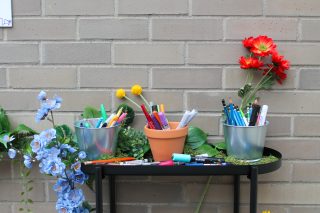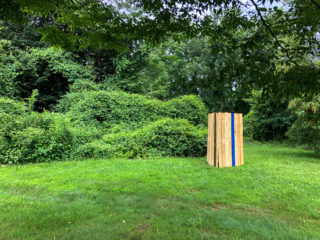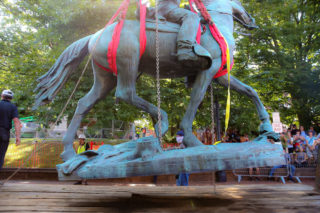
On January 21, Invader posted his first video from Bhutan on Instagram, revealing his first work in the Kingdom, installed inside a monastery beside a wall painting of a figure meditating. A landlocked country in South Asia, Bhutan is bordered by Tibet and two of India’s 29 states, and its national identity is founded in and inextricably tied to Buddhism. Ending the post with “…with the blessing of the monks !” to let people know he hadn’t just vandalized a sacred site without permission, the post’s comments start out positive and complimentary before devolving into vitriolic disgust for the artist’s “disrespect of cultural heritage” a week later.
These comments seem to be tied to a January 31 artnet article based on the experience of an American tourist, who reached out to the news outlet after personally witnessing Invader “defacing a building.” That article was picked up by Widewalls, Hypebeast and Asia One, with headlines that use words like “uproar” and “under fire.” But the Bhutanese perspective paints a slightly different—or at least more nuanced—picture. While some are indeed upset, others welcomed the works. On February 2, Bhutanese photographer Pawo Choyning Dorji posted a photo of Invader’s work in Clock Tower Square, vandalized after just a week. “We are so sorry,” he writes directly to the artist.
In his only English-language interview responding to this “uproar,” Invader shares his perspective:
Lindsey Davis: How did you decide on Bhutan for the invasion? What was it like working with the monks and the local community, and how did the idea for this invasion begin?
Invader: A dear friend of mine practices Tibetan Buddhism. On several occasions, he mentioned his trips to Bhutan and how much he enjoyed spending his time there.
I was very curious to visit this country and to meet its people. Bhutan is a place where nature and animals have a central place and where, for example, people plant a new tree when they need to cut another one. This was something that very much appealed to me.
My attraction grew bigger and bigger and I finally decided to make the long journey to the Kingdom of Bhutan. I therefore started creating eleven mosaic artworks tributing Bhutanese culture and Buddhism.
I travelled to the Himalayas bringing the artworks in my suitcase without knowing what to expect. In particular, I did not know how the Bhutanese people would react to my body of works and the contexts [in which] I display them. The monks and the local people I met have not only been extremely open-minded but very welcoming of my work.

LD:< What's your own relationship with religion like? How did your installations in Bhutan react to, or speak to, the centuries of Buddhist history and practice in Cheri Goemba? Invader: Before the trip, I did some research about religion and culture in Bhutan. The mosaics I created are my personal interpretation of Bhutanese symbolism.
I’ve always been interested by the spiritual aspect and the philosophy of life inherent to Buddhist practice.
LD: Have you ever installed work within a religious context before? How did that reaction compare to the reaction to your work in Bhutan?
Invader: I usually do not install my mosaics on religious buildings. It did happen a few times though, mainly because the function of the building was not obvious to me. I guess I was blinded by my artistic mission and just saw the good spot! Afterwards, either the pieces were accepted and kept or they were unwanted and removed.
In Bhutan, I received only positive reactions from the Bhutanese people, until my path crossed the one of an American tourist. He was upset about the artwork’s display and immediately started a campaign in Bhutan and through social media to demonize my work and poison the situation.
I’ve been surprised and saddened by some of the reactions. We are speaking only about a few square centimeters of tile. Only two of the eleven mosaics were displayed in a religious context and they were done with the blessing of the monks.
My intention was never to hurt anyone’s sensitivity. On the contrary, I saw my works as offerings to the temple and as gifts for the Bhutanese people on the street. This project has been my life for 20 years now and I’ve done it in 75 different cities around the world, before Bhutan. Above all my invasions are intended to be artistic and pacific, not aggressive or disrespectful.

LD: To what extent was the invasion a collaboration with the Cheri Goemba monks? Do the monks have any plans for the works you installed there in the future?
Invader: I did not have any plans to invade any temples or monasteries before my trip. My visit to the Cheri Goemba temple was part of a hike in the Himalayan mountains.
As always, I brought mosaic artworks along with me in case I found a good location to display one of them along the way. Once I reached the temple, I showed and explained my works to the monks who were taking care of the site. I asked them if they knew of a place I could display one of the artworks and if it was okay to do so.
I was hoping to be able to install a piece on one of the steps on the hike to the temple. The monks replied that they would like me to install the piece inside the temple. They brought me inside and proposed two locations for me to choose from. After I chose the location, I presented all the pieces I had in hand and asked them if they had any preferences about which one they would like for the temple. They chose the mosaic mandala and were, I believe, sincerely happy with it.


LD: Anything else you’d like to add or say about your work in Bhutan? Is there anything I missed, or is there anything that people are getting wrong that you’d like to correct?
Invader: I would like to thank all the Bhutanese people who sent me some comforting and supporting messages about what happened. I even received an invitation, from a very important and influential Buddhist Lama, to come back to Bhutan and install a piece in his monastery as a message of peace and positivity.

Since wrapping up his invasion a week ago, most of the eleven works installed in Bhutan have already been removed. While it’s unclear who exactly removed the piece in Clock Tower Square, the Bhutanese media outlet Kuensel reported on Tuesday that officials from the Division of Cultural Properties removed a number of the artist’s installations, including the one from that first Instagram post inside Cheri Goemba (also known as Chagri Monastery or Cheri Monastery). “Home ministry officials said they are studying the issue,” the article states, quoting home minister Dawa Gyaltshen who says that the ministry is investigating the issue and will share details once it reaches a conclusion. “However, some locals on social media expressed regret on the destruction of the artwork in the public places,” the article concedes.
The situation is not unlike the artist’s 2014 Hong Kong invasion, in which local authorities also systematically removed Invader’s installations. (Although of course, there was no religious offense implicated in this instance.) Here the uproar was in support of Invader: the local community lamented the loss of public artworks which the artist had installed for free. In response, Invader created a replica of one of the destroyed works and sold it for over $250,000—effectively proving the city had robbed its residents of millions in cultural value. Before the work was auctioned, it was included in the artist’s solo exhibition at HOCA (Hong Kong Contemporary Art) appropriately titled Wipe Out, so that the public still had access to the piece for a time.
“I’ve been surprised and saddened by some of the reactions. We are speaking only about a few square centimeters of tile.”





[…] an interview with ArtAround Arrow, Invader said the idea to travel to Bhutan was sparked by the experiences of a […]
[…] see also the artist’s interview on the […]